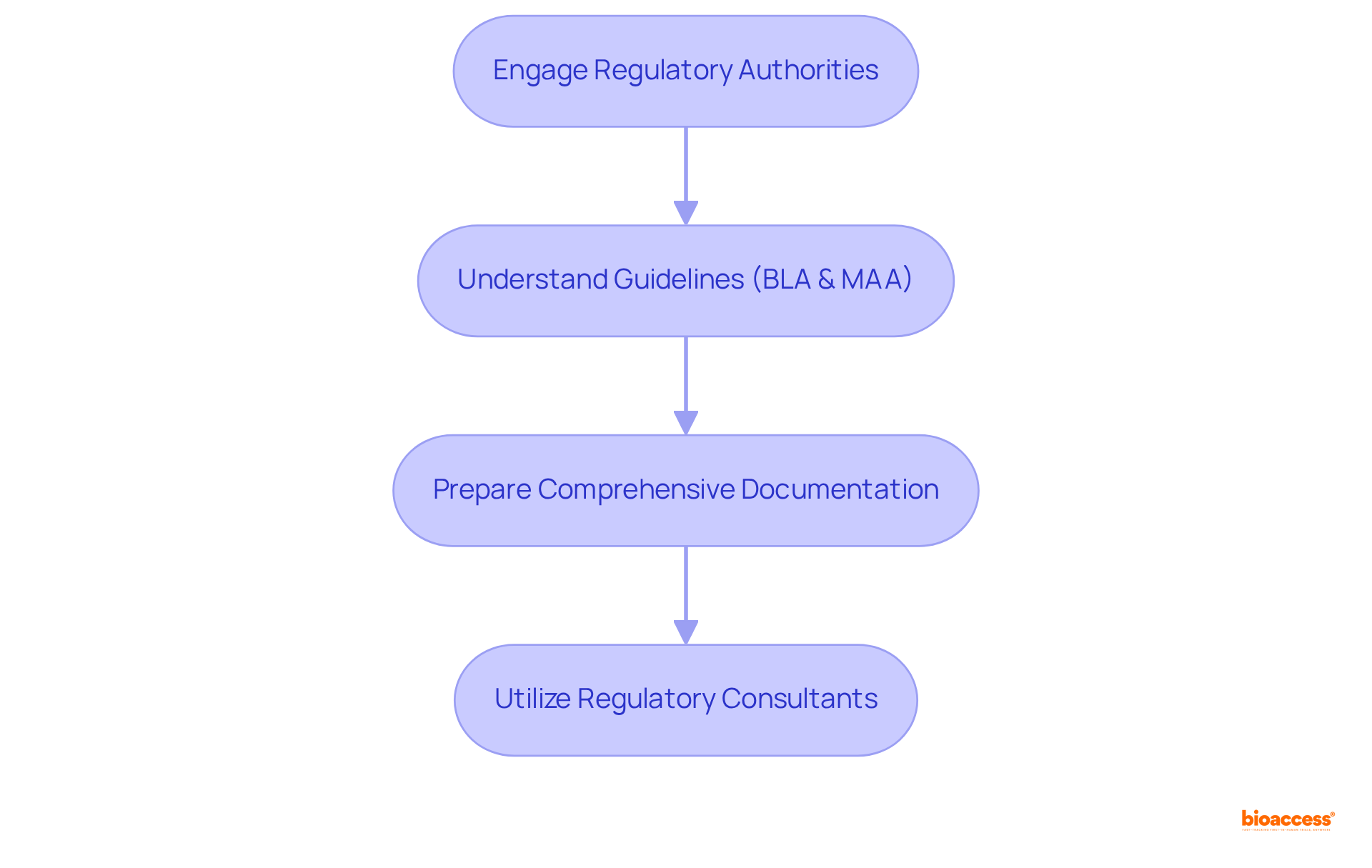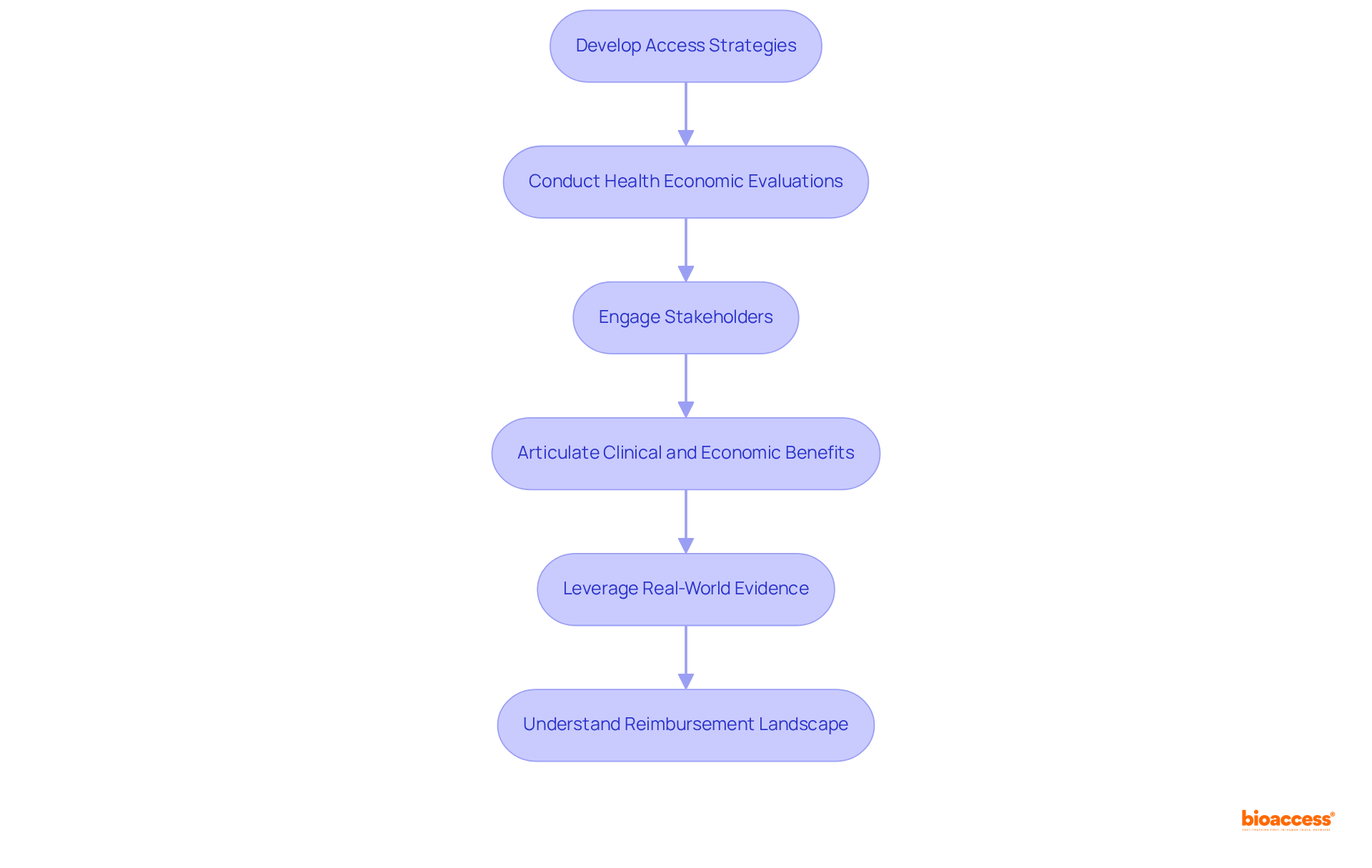


The article presents key strategies for mastering the development of large molecule drugs, underscoring the necessity of understanding their unique characteristics in contrast to small molecule drugs. It elucidates essential strategies, including:
These elements are crucial for successful commercialization and for addressing the complexities inherent in biologics.
Understanding the intricate landscape of drug development is essential, especially as large molecule medications—biologics—continue to capture a substantial share of the pharmaceutical market. Their complex structures and unique regulatory pathways present significant opportunities and daunting challenges for developers. As the industry anticipates a robust growth trajectory for biologics, a pressing question arises: what key strategies can ensure successful navigation through the complexities of large molecule development? This article delves into essential practices and innovative approaches that can empower companies to thrive in this evolving sector.
Large molecule medications, often referred to as biological products, are typically proteins or complex substances derived from living organisms. These biologics, being large molecules, exhibit high molecular weights and intricate structures, which necessitate specialized manufacturing and handling processes. In contrast, small molecule medications are chemically synthesized, characterized by lower molecular weights, and generally demonstrate greater stability and ease of administration. This fundamental distinction is vital for formulating effective strategies for drug development, delivery, and regulatory compliance.
For instance, biological therapies often require injection or infusion, which can significantly impact patient compliance and access strategies. In 2023, biological products accounted for approximately 42% of the pharmaceutical market, reflecting their rapid growth compared to small compounds, which constituted 58% of the market. As we look ahead to 2025, the biologics sector continues to expand, with a compound annual growth rate projected at 15% until 2027.
The key differences between large molecule drugs and small compound drugs also extend to their clinical trial processes. Biologics, such as monoclonal antibodies, encounter unique challenges that demand innovative approaches. This is where bioaccess® can play a pivotal role, providing services that address these challenges, including accelerated regulatory approval and efficient patient recruitment. Conversely, small compounds, like traditional analgesics, often navigate regulatory pathways with relative ease. The approval rates for small compounds hover around 10%-12%, while biologics enjoy a higher approval rate of approximately 20%-25%. Understanding these distinctions is crucial for optimizing pharmaceutical formulation and ensuring successful market entry. Leveraging bioaccess's expertise in regulatory processes and patient engagement can significantly enhance the efficiency of this process.

To successfully navigate regulatory requirements for large molecule drugs, developers must engage with regulatory authorities early in the process. This engagement is crucial for comprehending the specific guidelines for biological products, including the Biologics License Application (BLA) in the U.S. and the Marketing Authorization Application (MAA) in Europe. Developers should prepare comprehensive documentation that includes:
Statistics indicate that large molecules, such as biologics, typically experience quicker approval periods than small compounds, underscoring the significance of a well-organized strategy. For instance, the BLA for etuvetidigene autotemcel gene therapy for Wiskott-Aldrich Syndrome, which occurs in 1 in 250,000 male live births, illustrates the urgency and importance of the BLA process. Companies that proactively address potential regulatory challenges often experience smoother transitions through clinical phases and faster market entry. Engaging regulatory consultants, such as Ana Criado, Director of Regulatory Affairs at bioaccess® and CEO of Mahu Pharma, can further enhance this process. With her extensive background in biomedical engineering, health economics, and cannabis regulation, Ana offers valuable insights into best practices, prepares clients for pre-BLA meetings, and conducts mock FDA meetings. By leveraging bioaccess®'s services, companies can streamline their regulatory compliance efforts, ultimately accelerating their path to successful product approval.

Incorporating advanced technologies such as artificial intelligence (AI), machine learning, and high-throughput screening is essential for streamlining the drug development process for large molecules. These innovations enable rapid data analysis, enhance target identification, and optimize lead compounds.
For instance, AI can accurately predict interactions of large molecules and improve the design of biologics, significantly reducing reliance on trial-and-error methods. Furthermore, the implementation of real-time data monitoring platforms during clinical trials enhances decision-making and bolsters patient safety.
Companies that adopt these technologies often encounter shortened development timelines and reduced expenses, creating a more efficient route to commercialization. Notably, bioaccess® provides ethical approvals in 4-6 weeks and guarantees enrollment is 50% quicker than conventional sectors, achieving $25K savings per patient with FDA-ready data—no rework, no delays.
Given that only 1 out of 10 medical products enters clinical trials and is approved by the FDA for use on patients, leveraging these advanced technologies becomes crucial for improving success rates. As the biologics sector is anticipated to expand at a compound annual growth rate of 15% until 2027, employing these advanced technologies will be essential for sustaining a competitive advantage in the evolving landscape of pharmaceutical development focused on large molecules.

To ensure the successful commercialization of medications involving large molecules, companies must develop comprehensive access strategies that encompass pricing, reimbursement, and distribution channels. This process requires conducting health economic evaluations to demonstrate the medication's value to payers and healthcare providers. Engaging with stakeholders early on, including payers and patient advocacy organizations, provides critical insights into their needs and expectations. Companies that effectively articulate the clinical and economic benefits of their products frequently secure favorable reimbursement terms, which in turn facilitates broader patient access.
Moreover, leveraging real-world evidence can strengthen access proposals and enhance the product's value proposition. Notably, 57% of medication launch failures are attributed to limited access, underscoring the necessity of these strategies. Additionally, with average reimbursement times for branded drugs varying from 282 days in Germany to 665 days in Canada, a thorough understanding of the reimbursement landscape is imperative.
As the biologics market, driven by large molecules, is anticipated to expand at a compound annual growth rate of 15% until 2027, the evolving landscape of market access strategies becomes increasingly crucial.

Mastering the development of large molecules necessitates a nuanced understanding of the distinctions between large and small molecule drugs, coupled with strategic planning for regulatory compliance and market access. As the biologics sector continues its expansion—propelled by innovations and the unique characteristics of large molecules—companies must adopt specialized strategies to effectively navigate the complexities of development.
Key insights reveal critical distinctions in:
The advantages of employing advanced technologies, such as AI and real-time data monitoring, emerge as essential tools for enhancing efficiency and success rates in drug development. Furthermore, the significance of strategic market access planning is underscored, as it directly influences the successful commercialization of biologics.
In light of these considerations, pharmaceutical companies are urged to embrace these best practices and innovations to maintain competitiveness in a rapidly evolving landscape. By prioritizing comprehensive strategies that encompass regulatory engagement, technological integration, and market access, stakeholders can significantly enhance their chances of success in the burgeoning field of large molecule drug development.
What are large molecule drugs?
Large molecule drugs, often referred to as biological products, are typically proteins or complex substances derived from living organisms. They exhibit high molecular weights and intricate structures.
How do small molecule drugs differ from large molecule drugs?
Small molecule drugs are chemically synthesized, characterized by lower molecular weights, and generally demonstrate greater stability and ease of administration compared to large molecule drugs.
What percentage of the pharmaceutical market do biological products represent as of 2023?
As of 2023, biological products accounted for approximately 42% of the pharmaceutical market.
What is the projected growth rate for the biologics sector until 2027?
The biologics sector is projected to grow at a compound annual growth rate of 15% until 2027.
What challenges do biological therapies face in clinical trials?
Biological therapies, such as monoclonal antibodies, encounter unique challenges during clinical trials that require innovative approaches for successful development.
What is the approval rate for small compounds compared to biologics?
The approval rate for small compounds is around 10%-12%, while biologics have a higher approval rate of approximately 20%-25%.
How can bioaccess® assist in the drug development process?
Bioaccess® provides services that address challenges in the development of biologics, including accelerated regulatory approval and efficient patient recruitment, enhancing the efficiency of the drug development process.